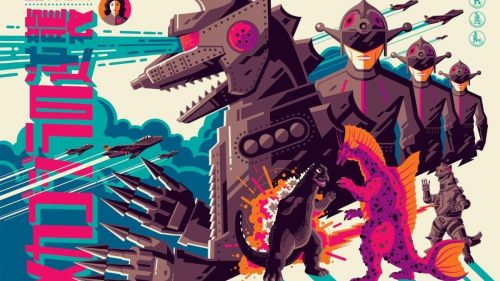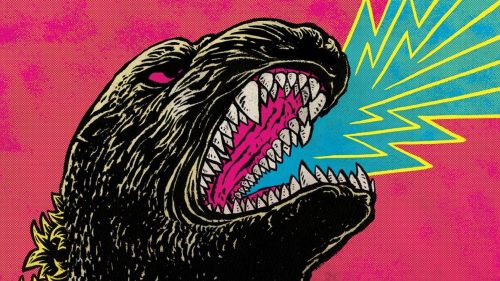Godzilla Week: GODZILLA VS SPACEGODZILLA
Godzilla: King of the Monsters is almost here. Get your tickets now!
When the son of a reclusive vigilante is kidnapped by a new, mysterious, all-powerful eco-terrorist, the rogue anti-hero must work with their worst enemy – humans – to save their child and the world as we know it.
Sounds like a new installment of the Fast franchise, right? Or perhaps the next xXx sequel? Or a Taken spin-off? That's the premise of Godzilla Vs. SpaceGodzilla, directed by Kensho Yamashita in 1994. Made during the Heisei era of the late '80s to mid-'90s, Godzilla Vs. SpaceGodzilla is very much a product of the time – bigger action and special effects, with more overarching plot and character threads. The canon had been reset, allowing Toho to create a cohesive kaiju universe from scratch, or as cohesive as kaiju universes get given the subject matter.
On its face, the movie is typical of Godzilla sequels: a weird, slapshot villain, lots of city-stomping in the back-half and human protagonists that have a difficult relationship with their monster-inhabited Earth. But the entry is one that's deeply conscious of what Godzilla and his kaiju brethren mean, and who the real antagonist in all of this is.
Before the titular SpaceGodzilla arrives, the Japanese government is working on two distinct plans to handle Godzilla. There's M.O.G.U.E.R.A. (Mobile Operations G-Force Universal Expert Robot: Aero-type), essentially a human-controlled MechaGodzilla, and Project T, an experiment to create a telepathic connection with Godzilla so the military can control him. Scientists are sent to the big G's island home to work on the latter, shooting him with a transponder that will allow Miki Saegusa, a recurring character of the period who has psychic powers, to mentally communicate with him. In the meantime, Godzilla's son is roaming around, getting into trouble as he incidentally springs traps meant for his father.
M.O.G.U.E.R.A. is deployed to intercept SpaceGodzilla on its path to Earth, but fails to stop the anomaly. Soon, SpaceGodzilla lands on Godzilla's island, trapping his son and swiftly defeating the king of the monsters in a fight. SpaceGodzilla then heads for mainland Japan, with Godzilla on its tail.
Godzilla Vs. SpaceGodzilla is about the need for co-dependence in order for survival. Many of the humans want Godzilla either dead or under their finger, despite any attempts to do either always going wrong. A major subplot here involves a rogue scientist capturing Miki to try and force her telepathic powers to work on Godzilla, literally stating he just wants the power. Here, Godzilla as an unruly manifestation of our desire for destruction is a challenge to some – an invitation to try and become the one that gets a handle on such devastating capabilities.
It's the opposite that needs to happen. A recurring motif has fairies of Mothra visit X, telling her that all living things must work together to defeat great evil, and that all things have a right to exist in tranquility. SpaceGodzilla stands as an analogy for the pandora's box of the military industrial complex and the rage of Mother Earth – once something like Godzilla has been given life, that's just the start. The arms race has now reached a new standard and humans just have to find a new way to exist in the eco-system.
This has all grown only more relevant as we, just short of 25 years after this picture first came out, continue to reckon with climate change. We're still locked in a protracted boardroom meeting where those in power often deny the evidence and do things out of ego and capitalism, favoring shareholders over our actual planet.
Godzilla Vs. SpaceGodzilla isn't especially profound in this, but to me that's part of the charm. The contrast of the tiny humans with their absolute belief that they matter with the massive behemoths that slowly come together for the climactic clash only further drives home the point. This is all so much bigger than we can contemplate and our greatest folly is thinking that we're special and that something might still save us if we make the wrong choice. Hell, Godzilla's even fighting for his kid, an unsubtle reminder that when it comes to the future, it's all about who's inheriting it.
As action-packed thrillers go, none of this is as slick or well-acted as the franchises mentioned above, but there's a sincerity to it that I find is often missed in typical American blockbusters. There's rarely pretension in kaiju movies. There can't be because the central action is being made by guys in rubber suits and fancy lightshows. They're the opposite of star-vehicles, and in that, they're cinema without the baggage of wondering who's trying to sell you what. Nobody's going for a round of Bud Light in Godzilla Vs. SpaceGodzilla, or conspicuously showing up in the latest Porsche, or suddenly taking out the newest Samsung so we can all see how nice it looks.
In Godzilla movies, we are at the behest of him and whatever apocalypse he's embroiled in. Over the years, Godzilla has evolved to be both our past and our future, forever colliding – he is our worst mistake and our greatest hope. The characters can choose to help, like they do with M.O.G.U.E.R.A., and form an alliance that works towards the betterment of this rock hurtling through space we call home, or we can chop off our nose to spite our face. Either way, the best we can hope for is survival, and for that we must be better to every living thing around us – no matter how big and scary we find them.



